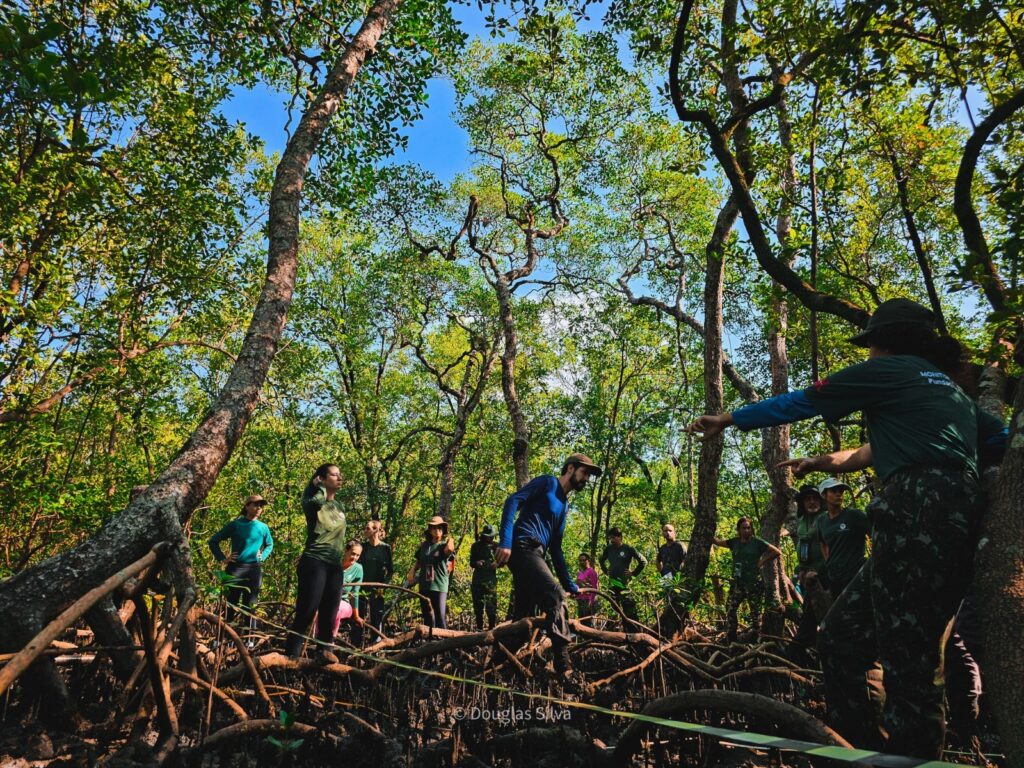Mangroves are vital carbon sinks, but they suffer degradation. Understand its importance, climate risks, and challenges of restoration in Brazil.
On July 26, its celebrated the International Day for the Conservation of. In 2015, the United Nations Educational, Scientific and Cultural Organization, UNESCO, adopted the date to raise awareness about the importance of mangroves.
The celebration includes everything from the conservation of the ecosystem to the recovery of degraded mangrove areas. After all, mangroves provide essential ecosystem services for nature. And, in addition to being complex ecosystems, with specific vegetation and fauna, they also act as carbon sinks.
What are mangroves and why are they important?
Mangroves are coastal ecosystems rich in biodiversity and fundamental in combating climate change. As large carbon sinks, they store organic matter in soil for thousands of years. However, the degradation of these areas can turn this carbon into greenhouse gases, such as CO₂ and methane, aggravating global warming.
Mangroves are wetlands located between land and sea, composed of salt-tolerant vegetation and wetlands. They offer coastal protection, sustain biodiversity and sequester large amounts of so-called ‘blue carbon’, being considered one of the most productive ecosystems on the planet.
The storage capacity per area of carbon in mangroves is 4 to 6 times greater than that stored in tropical, boreal and temperate forests. Globally, most of this carbon (85%) is stored in mangrove soils, where it remains for centuries – as long as the ecosystem is not disturbed.
Mangroves in Brazil and in the world
Globally, mangroves cover between 13.8 and 15.2 million hectares. However, deforestation reduces these areas by about 2% per year. According to UNESCO, about 67% of global mangroves have been lost or degraded in recent decades.
Brazil has the second largest area of mangroves in the world, covering about 7% of the global extension — approximately 1 million hectares — and concentrating about 8.5% of global carbon stocks in mangroves, considering both biomass and soils. Protecting these ecosystems is vital for both biodiversity and the climate. Some of the ecosystem services provided by mangroves are:
- Protect coasts from erosion and storms;
- They function as nurseries for fish, crustaceans and molluscs;
- They purify water and filter pollutants;
- They store large amounts of carbon;
- Ensure income and food security for coastal communities;
Degradation and emission of greenhouse gases
Mangroves have been accumulating carbon for thousands of years. When they are deforested or degraded, the carbon stored in soils is exposed to oxygen. This accelerates microbial decomposition, resulting in the emission of carbon dioxide (CO₂) and methane (CH₄).
Methane is released in smaller quantities, but it is more dangerous. According to the World Resources Institute (WRI), it is 86 times more potent than CO₂ for global warming over a 20-year period.
| How does methane production occur? |
| The release of methane is linked to the activity of methanogenic archaea, microorganisms that live in anaerobic sediments. When the area is drained or disturbed, methane production increases, compounding the environmental impact. |
Why is mangrove restoration challenging in Brazil?
Despite efforts, many mangrove restoration projects in Brazil have not been successful. This is because most do not consider the environmental stressors, which are pollution, changes in water flow and irregular urban occupations.
To effectively restore mangroves, it is necessary to adopt science-based practices, respecting the natural dynamics of ecosystems and involving local communities in the process.
Brazil’s role in protecting blue carbon
Brazil has a strategic role in the conservation of blue carbon, thanks to the extension and diversity of its mangroves.
Conserving mangroves is one of the most effective Nature-Based Solutions (NBS) against climate change and global biodiversity loss.
Mangroves are essential ecosystems for climate, biodiversity, and human communities. They are sources of life and natural barriers against climate breakdown. However, its existence is threatened by anthropogenic pressures and fragile public policies.
With the aim of strengthening their preservation, researchers from CCARBON/USP are engaged in an initiative that monitors mangroves along the São Paulo coastline. In partnership with Fundação Florestal, the project studies carbon stocks and the presence of potentially toxic elements in these ecosystems. This initiative represents a step forward in environmental monitoring and is part of Fundação Florestal’s Integrated Mangrove Management Program, established by Normative Ordinance FF 445/2024.
Preserving and restoring these environments is urgent. Mangrove conservation is a collective, local and global responsibility. Investing in environmental education, scientific research, and sustainable management is the way to ensure that these ecosystems continue to fulfill their vital role for the planet.
References:
Blue Carbon Initiative. (2023). Mitigating climate change through coastal conservation. https://www.thebluecarboninitiative.org/
Giri, C., Ochieng, E., Tieszen, L. L., Zhu, Z., Singh, A., Loveland, T., … & Duke, N. (2011). Status and distribution of mangrove forests of the world using earth observation satellite data. Global ecology and biogeography, 20(1), 154-159. https://doi.org/10.1111/j.1466-8238.2010.00584.x
Goldstein, A., Turner, W. R., Spawn, S. A., Anderson-Teixeira, K. J., Cook-Patton, S., Fargione, J., … & Hole, D. G. (2020). Protecting irrecoverable carbon in Earth’s ecosystems. Nature Climate Change, 10(4), 287-295. https://doi.org/10.1038/s41558-020-0738-8
Instituto Socioambiental & ICMBio. (2018). Atlas dos manguezais do Brasil (176 p.). Brasília: Instituto Socioambiental. https://acervo.socioambiental.org/sites/default/files/documents/17L00001.pdf
National Geographic Brasil. (2022). O que são os manguezais e por que é importante conservá-los. https://www.nationalgeographicbrasil.com/meio-ambiente/2022/07/o-que-sao-os-manguezais-e-por-que-e-importante-conserva-los
ONU Brasil. (2023, 26 julho). 67% dos manguezais da Terra foram perdidos ou degradados, alerta PNUMA. https://brasil.un.org/pt-br/130784-67-dos-manguezais-da-terra-foram-perdidos-ou-degradados-alerta-pnuma
Rogers, K., Kelleway, J. J., Saintilan, N., Megonigal, J. P., Adams, J. B., Holmquist, J. R., … & Woodroffe, C. D. (2019). Wetland carbon storage controlled by millennial-scale variation in relative sea-level rise. Nature, 567(7746), 91-95. https://doi.org/10.1038/s41586-019-0951-7
Ross, K., Waskow, D., & Ge, M. (2021). Como as emissões de metano contribuem com mudanças climáticas. WRI Brasil. https://www.wribrasil.org.br/noticias/como-emissoes-de-metano-contribuem-com-mudancas-climaticas
Rovai, A. S., Twilley, R. R., Worthington, T. A., & Riul, P. (2022). Brazilian mangroves: blue carbon hotspots of national and global relevance to natural climate solutions. Frontiers in Forests and Global Change, 4, 787533. https://doi.org/10.3389/ffgc.2021.787533
By: Mariana Pezzatte Pollo, CCARBON/USP
How to cite this article:
POLLO, M. P. International Mangrove Conservation Day. CCARBON/USP, 2025. Available at: <LINK>. Accessed on: DATE






